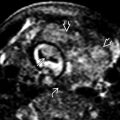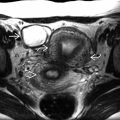KEY FACTS
Terminology
- •
Cleft lip (CL) occurs ± cleft palate (CP)
- ○
> 80% of fetuses with CL also have CP
- ○
- •
Variable classifications, best to be descriptive about defects
- ○
Unilateral (right or left), bilateral, midline
- ○
Complete CL: Defect extends to nose (nares)
- ○
Incomplete CL: Cleft does not extend to nares
- ○
- •
Primary palate: Front of palate (alveolar ridge)
- •
Secondary palate: Back of palate (soft + hard palate)
Imaging
- •
Unilateral CL + CP is most common type
- ○
CL extends to nose and flattens nares
- ○
Seen best on standard coronal nose-lip view
- ○
- •
Bilateral CL/CP
- ○
Alveolar ridge becomes mass-like and bulges forward
- ○
Profile view best to see premaxillary protrusion
- ○
- •
Midline CL/CP: Central lip and palate defect
- ○
Flat midface and nose
- ○
- •
Isolated CP without CL is highly associated with small chin
- ○
Palate defect is deep (posterior to alveolar ridge)
- ○
- •
3D ultrasound helpful for making specific diagnosis
- ○
Helps family and maxillofacial team prepare
- ○
- •
Associations: Aneuploidy, brain, and cardiac anomalies
- ○
Trisomy 13, trisomy 18, > 200 syndromes
- ○
More likely with midline and bilateral CL/CP
- ○
Scanning Tips
- •
Best to obtain 3D volume from profile view
- ○
Use soft tissue post processing to determine if CL extends to nares and their appearance (often flattened)
- ○
Use axial plane and bone postprocessing coronal images to best evaluate palate defect
- ○
- •
When chin is small, look for fluid extending from mouth to nasal cavity posteriorly (soft tissue palate defect)
- •
Scan carefully for other anomalies, especially brain and heart

 . The flattened naris
. The flattened naris  is seen best with 3D. This fetus also had CP. Treatment includes multiple surgeries and presurgical nasal alveolar molding.
is seen best with 3D. This fetus also had CP. Treatment includes multiple surgeries and presurgical nasal alveolar molding.
 (and beyond).
(and beyond).











